coolant temperature TOYOTA TACOMA 2013 Owners Manual (in English)
[x] Cancel search | Manufacturer: TOYOTA, Model Year: 2013, Model line: TACOMA, Model: TOYOTA TACOMA 2013Pages: 524, PDF Size: 10.96 MB
Page 155 of 524
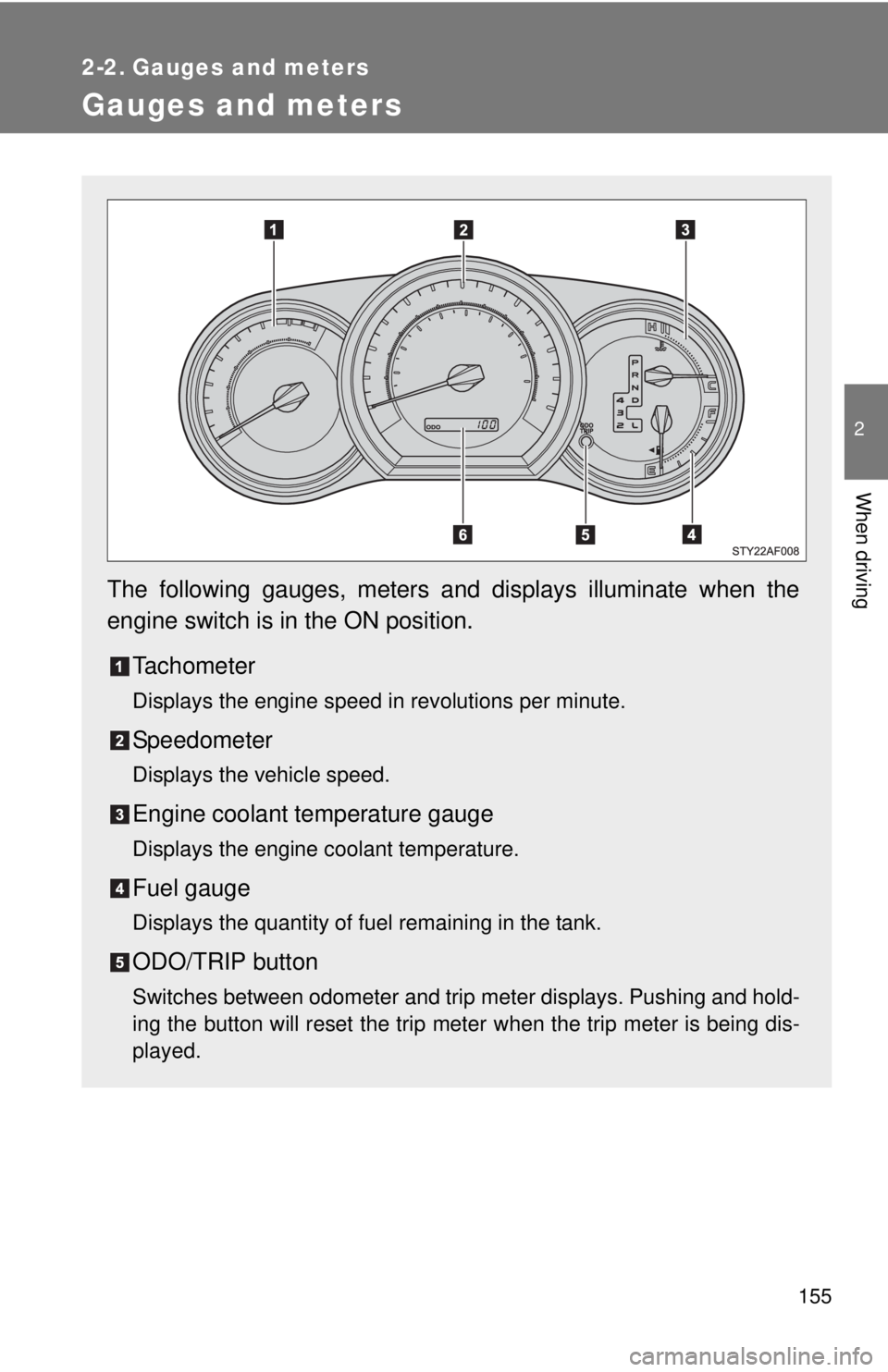
155
2
When driving
2-2. Gauges and meters
Gauges and meters
The following gauges, meters and displays illuminate when the
engine switch is in the ON position.Tachometer
Displays the engine speed in revolutions per minute.
Speedometer
Displays the vehicle speed.
Engine coolant temperature gauge
Displays the engine coolant temperature.
Fuel gauge
Displays the quantity of fuel remaining in the tank.
ODO/TRIP button
Switches between odometer and trip meter displays. Pushing and hold-
ing the button will reset the trip meter when the trip meter is being dis-
played.
Page 157 of 524

157
2-2. Gauges and meters
2
When driving
NOTICE
■
To prevent damage to the engine and its components
●Do not let the indicator needle of the tachometer enter the red zone, which
indicates the maximum engine speed.
● The engine may be overheating if the engine coolant temperature gauge is
in the red zone (H). In this case, immediately stop the vehicle in a safe
place, and check the engine after it has cooled completely. (
P. 437)
Page 236 of 524
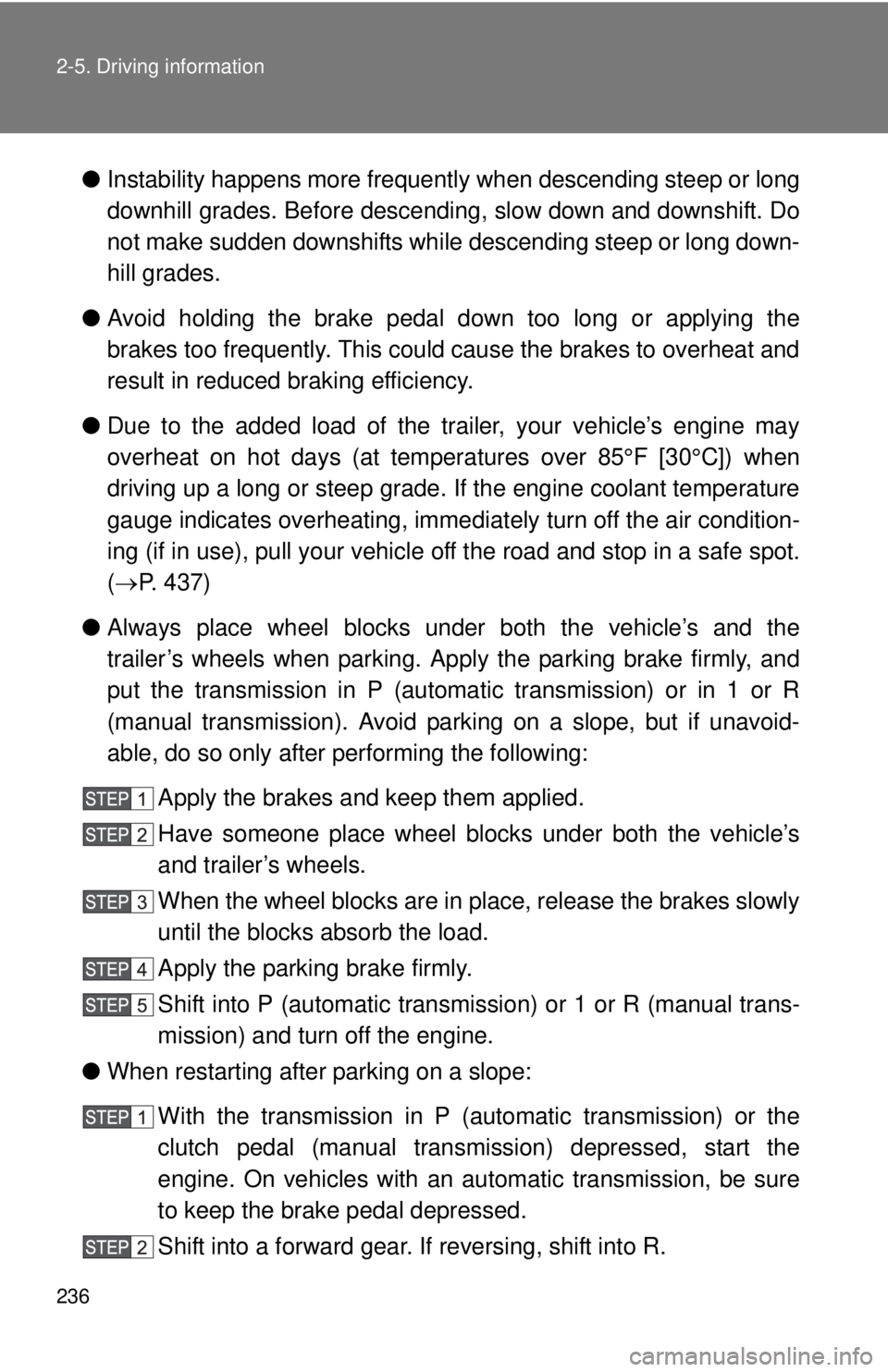
236 2-5. Driving information
●Instability happens more frequently when descending steep or long
downhill grades. Before descending, slow down and downshift. Do
not make sudden downshifts while descending steep or long down-
hill grades.
● Avoid holding the brake pedal down too long or applying the
brakes too frequently. This could cause the brakes to overheat and
result in reduced braking efficiency.
● Due to the added load of the trailer, your vehicle’s engine may
overheat on hot days (at temper atures over 85°F [30°C]) when
driving up a long or steep grade. If the engine coolant temperature
gauge indicates overheating, immediately turn off the air condition-
ing (if in use), pull your vehicle off the road and stop in a safe spot.
( P. 437)
● Always place wheel blocks under both the vehicle’s and the
trailer’s wheels when parking. Ap ply the parking brake firmly, and
put the transmission in P (automatic transmission) or in 1 or R
(manual transmission). Avoid park ing on a slope, but if unavoid-
able, do so only after performing the following:
Apply the brakes and keep them applied.
Have someone place wheel blo cks under both the vehicle’s
and trailer’s wheels.
When the wheel blocks are in place, release the brakes slowly
until the blocks absorb the load.
Apply the parking brake firmly.
Shift into P (automatic transmission) or 1 or R (manual trans-
mission) and turn off the engine.
● When restarting after parking on a slope:
With the transmission in P (automatic transmission) or the
clutch pedal (manual transmission) depressed, start the
engine. On vehicles with an au tomatic transmission, be sure
to keep the brake pedal depressed.
Shift into a forward gear. If reversing, shift into R.
Page 330 of 524

330 4-3. Do-it-yourself maintenance
CAUTION
The engine compartment contains many mechanisms and fluids that may
move suddenly, become hot, or become electrically energized. To avoid death
or serious injury observe the following precautions.
■When working on the engine compartment
●Keep hands, clothing, and tools away from the moving fan and engine
drive belt.
● Be careful not to touch the engine, radiator, exhaust manifold, etc. right
after driving as they may be hot. Oil and other fluids may also be hot.
● Do not leave anything that may burn easily, such as paper or rags, in the
engine compartment.
● Do not smoke, cause sparks or expose an open flame to fuel or the bat-
tery. Fuel and battery fumes are flammable.
● Be extremely cautious when working on the battery. It contains poisonous
and corrosive sulfuric acid.
● Take care because brake fluid can harm your hands or eyes and damage
painted surfaces.
If fluid gets on your hands or in your eyes, flush the affected area with
clean water immediately.
If you still experience discomfort, see a doctor.
■ When working near the cooling fan or radiator grille
Be sure the engine switch is off.
With the engine switch on, the cooling fan may automatically start to run if
the air conditioning is on and/or the coolant temperature is high.
■ Safety glasses
Wear safety glasses to prevent flying or falling material, fluid spray, etc. from
getting in the eyes.
Page 401 of 524
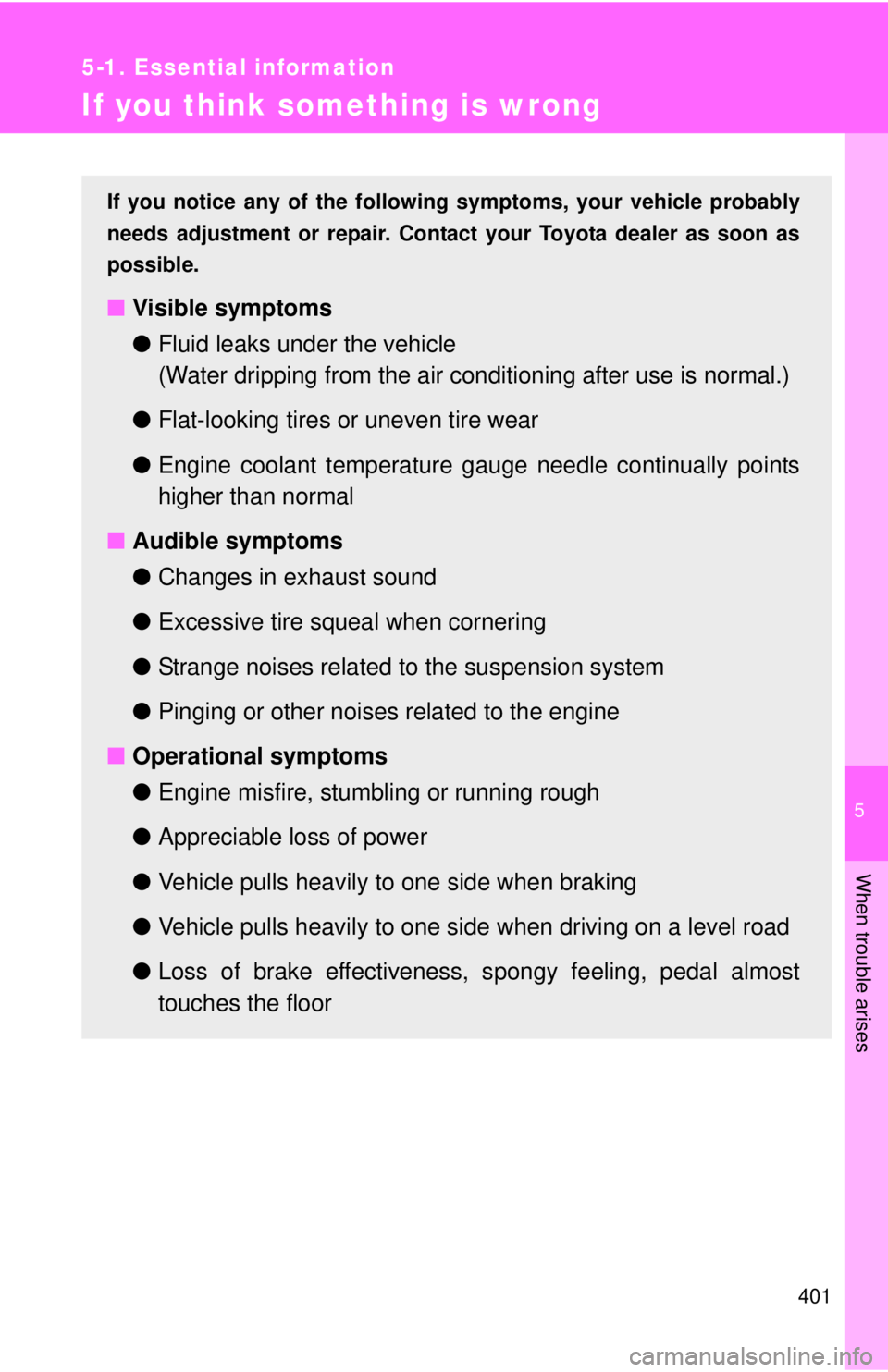
5
When trouble arises
401
5-1. Essential information
If you think something is wrong
If you notice any of the following symptoms, your vehicle probably
needs adjustment or repair. Contact your Toyota dealer as soon as
possible.
■ Visible symptoms
●Fluid leaks under the vehicle
(Water dripping from the air cond itioning after use is normal.)
● Flat-looking tires or uneven tire wear
● Engine coolant temperature g auge needle continually points
higher than normal
■ Audible symptoms
●Changes in exhaust sound
● Excessive tire squeal when cornering
● Strange noises related to the suspension system
● Pinging or other noises related to the engine
■ Operational symptoms
●Engine misfire, stumbling or running rough
● Appreciable loss of power
● Vehicle pulls heavily to one side when braking
● Vehicle pulls heavily to one side when driving on a level road
● Loss of brake effectiveness, s pongy feeling, pedal almost
touches the floor
Page 437 of 524
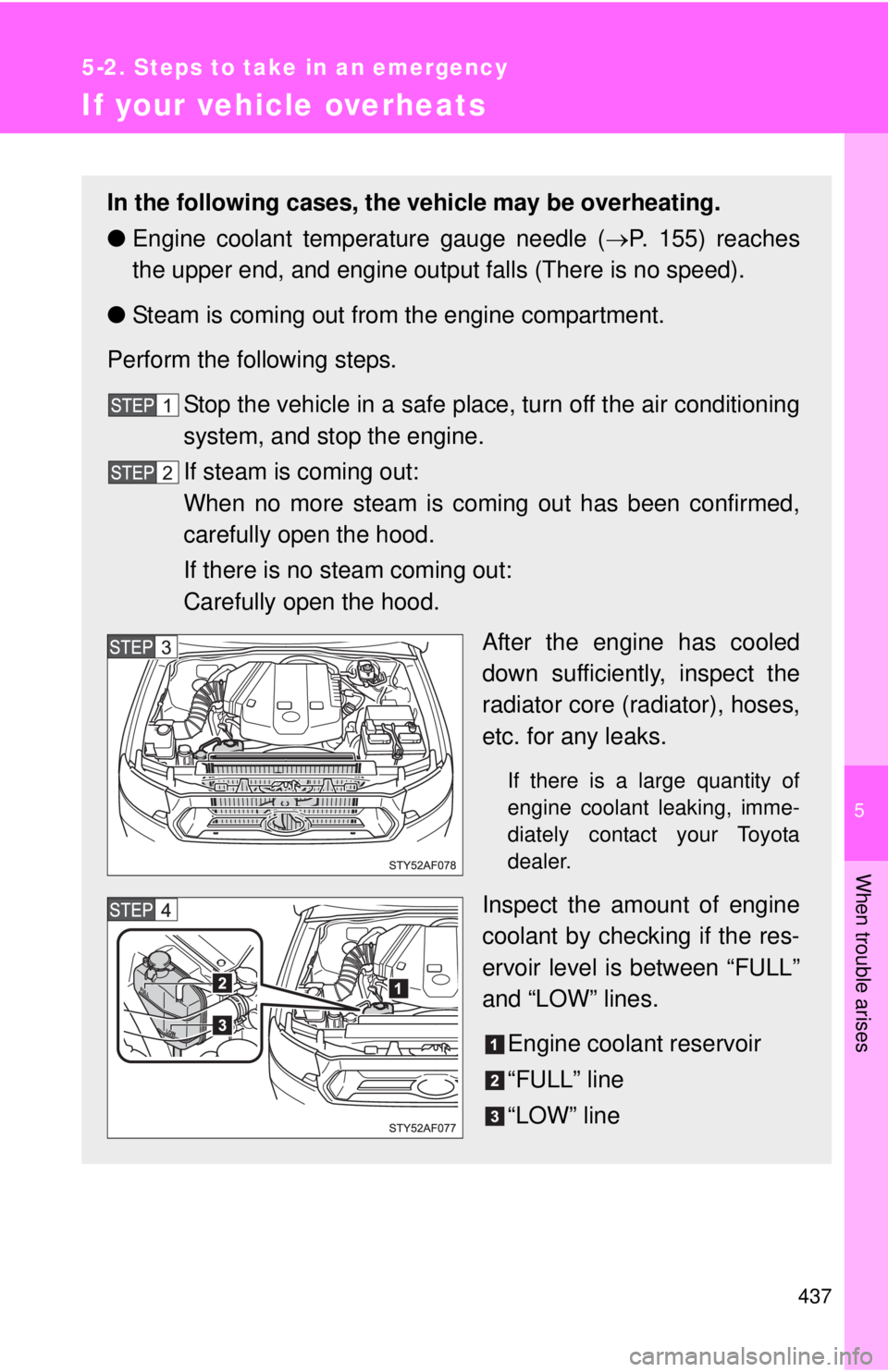
5
When trouble arises
437
5-2. Steps to take in an emergency
If your vehicle overheats
In the following cases, the vehicle may be overheating.
●Engine coolant temperature gauge needle ( P. 155) reaches
the upper end, and engine output falls (There is no speed).
● Steam is coming out from the engine compartment.
Perform the following steps.
Stop the vehicle in a safe place, turn off the air conditioning
system, and stop the engine.
If steam is coming out:
When no more steam is coming out has been confirmed,
carefully open the hood.
If there is no steam coming out:
Carefully open the hood. After the engine has cooled
down sufficiently, inspect the
radiator core (radiator), hoses,
etc. for any leaks.
If there is a large quantity of
engine coolant leaking, imme-
diately contact your Toyota
dealer.
Inspect the amount of engine
coolant by checking if the res-
ervoir level is between “FULL”
and “LOW” lines.
Engine coolant reservoir
“FULL” line
“LOW” line
Page 475 of 524
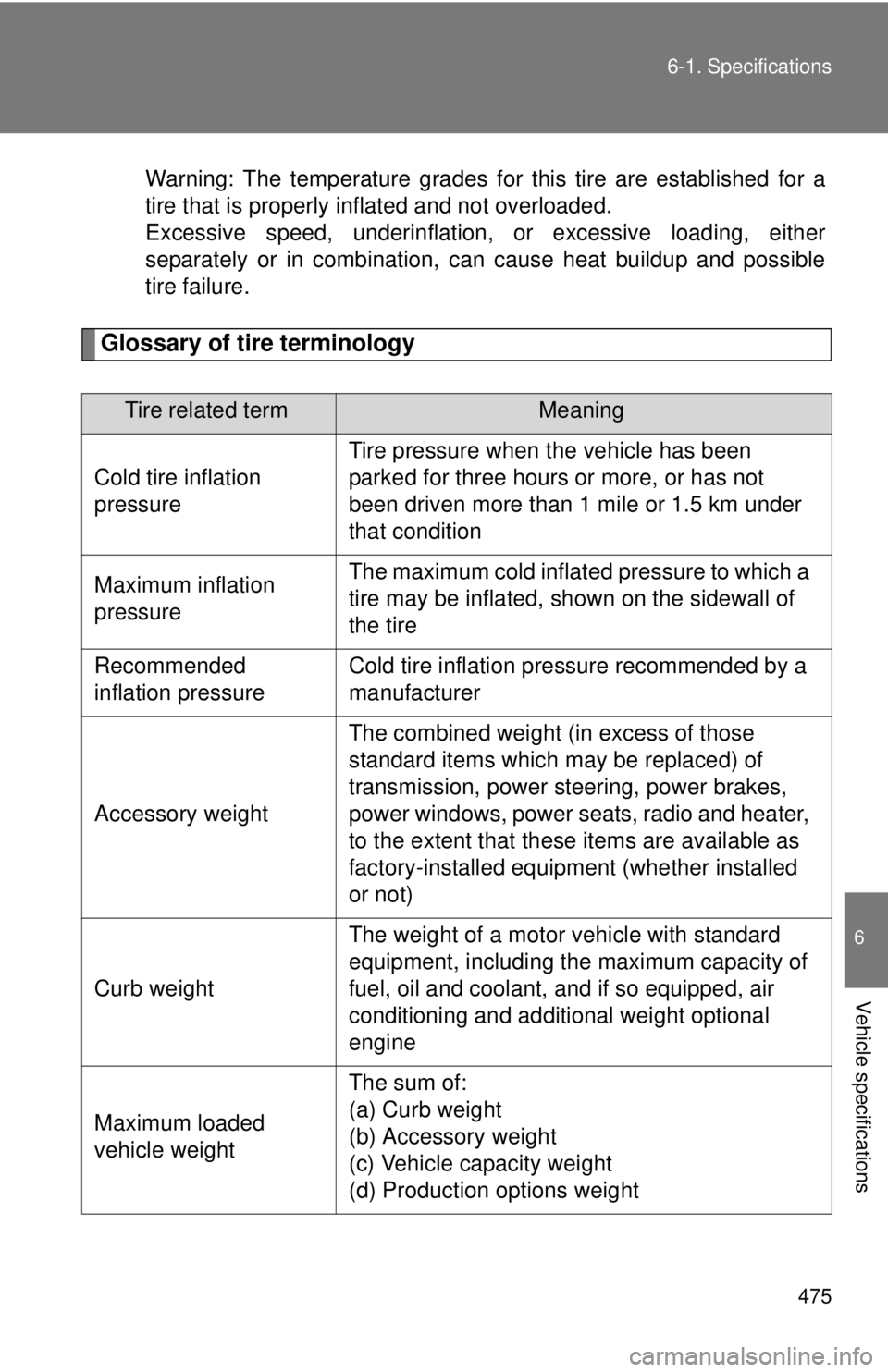
475
6-1. Specifications
6
Vehicle specifications
Warning: The temperature grades for this tire are established for a
tire that is properly inflated and not overloaded.
Excessive speed, underinflation,
or excessive loading, either
separately or in combination, can cause heat buildup and possible
tire failure.
Glossary of tire terminology
Tire related termMeaning
Cold tire inflation
pressure
Tire pressure when the vehicle has been
parked for three hours or more, or has not
been driven more than 1 mile or 1.5 km under
that condition
Maximum inflation
pressureThe maximum cold inflated pressure to which a
tire may be inflated, s hown on the sidewall of
the tire
Recommended
inflation pressureCold tire inflation pressure recommended by a
manufacturer
Accessory weight
The combined weight (in excess of those
standard items which may be replaced) of
transmission, power steering, power brakes,
power windows, power seats, radio and heater,
to the extent that these items are available as
factory-installed equipment (whether installed
or not)
Curb weight
The weight of a motor vehicle with standard
equipment, including the maximum capacity of
fuel, oil and coolant, and if so equipped, air
conditioning and additional weight optional
engine
Maximum loaded
vehicle weight
The sum of:
(a) Curb weight
(b) Accessory weight
(c) Vehicle capacity weight
(d) Production options weight
Page 514 of 524

514 Alphabetical index
DrivingBreak-in tips .......................... 132
Correct posture .......................85
Driving assist systems........... 198
Procedures ............................ 130
Winter driving tips.................. 217
Emergency, in case of Blown fuse............................. 372
If the engine will not start ...... 430
If the shift lever cannot be shifted from P...................... 431
If the vehicle battery is
discharged .......................... 433
If the warning buzzer sounds ................................ 403
If the warning light turns on ... 403
If you have a flat tire ............. 413
If you lose your keys ............. 432
If you think something is wrong .................................. 401
If the vehicle becomes
stuck ................................... 440
If your vehicle has to be stopped in an emergency ... 442
If your vehicle needs to be towed .................................. 395
If your vehicle overheats ....... 437
Emergency flashers Switch.................................... 394
Engine
Compartment ........................ 334
Engine switch ........................ 141
Exhaust gas .......................... 137
Hood...................................... 332
How to start the engine ......... 141
Identification number ............. 451
If the engine will not start ...... 430
Ignition switch........................ 141
Immobilizer system .................82
Overheating........................... 437
Warning light ......................... 404 Engine coolant
Capacity ................................ 457
Checking ............................... 340
Preparing and checking before winter ....................... 217
Temperature gauge .............. 155
Engine coolan t temperature
gauge ...................................... 155
Engine immobilizer system ...... 82
Engine oil Capacity ................................ 454
Checking ............................... 336
Preparing and checking before winter ....................... 217
Warning light ......................... 404
Engine switch........................... 141
Event data recorder ................... 27
Floor mat .................................. 287
Fluid Brake..................................... 342
Washer.................................. 348
Fog lights Replacing light bulbs ............. 385
Switch ................................... 165
Wattage................................. 466
Four-wheel drive system Front-wheel drive control
switch.................................. 184
Front fog lights Replacing light bulbs ............. 385
Switch ................................... 165
Wattage................................. 466
Front passenger occupant
classification system ............ 101
Front passenger’s seat belt reminder light ........................ 406
Front passenger’s seat belt warning buzzer ...................... 406
Front seats
Adjustment .............................. 47
E
F
Page 521 of 524
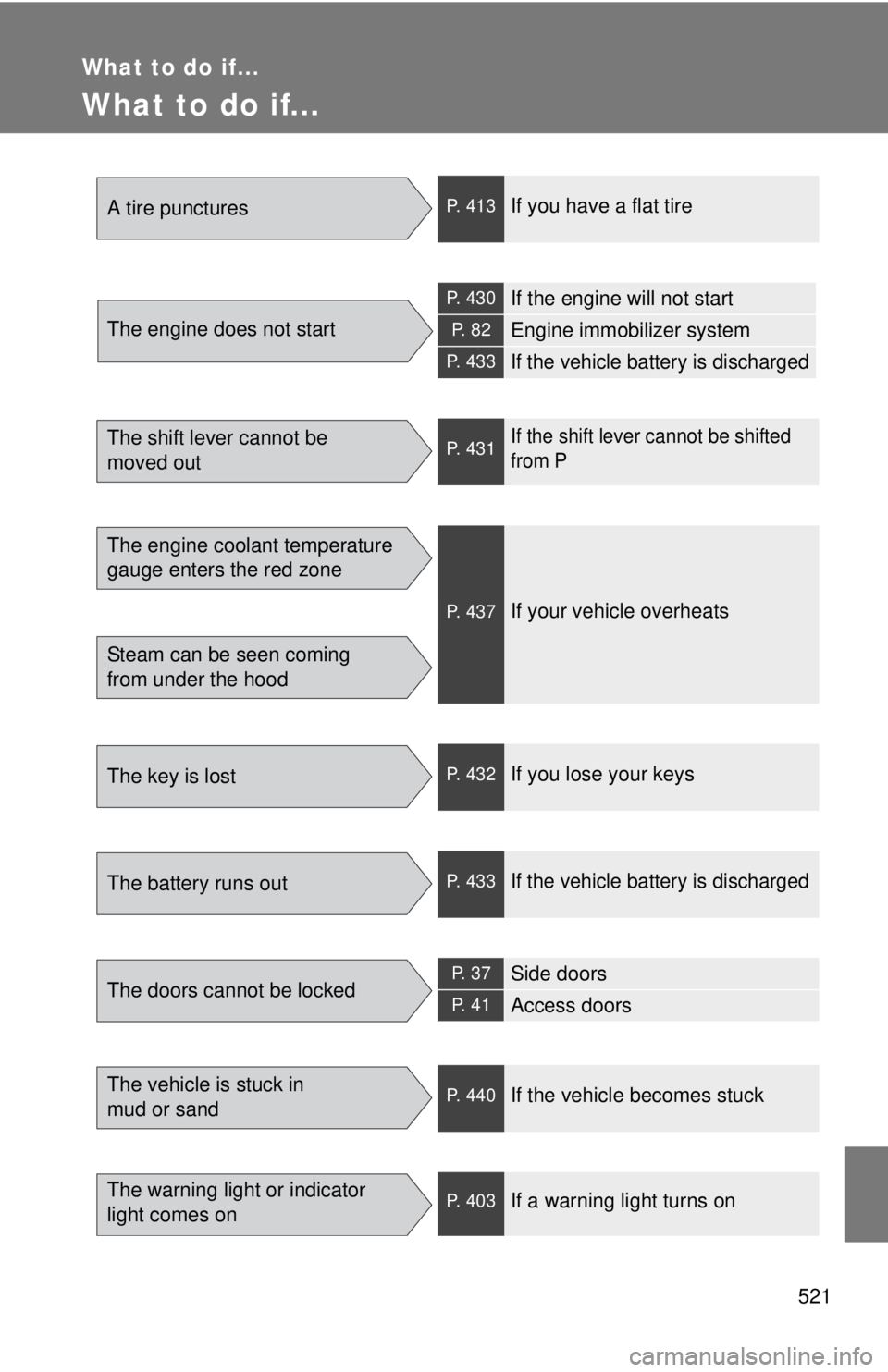
521
What to do if...
What to do if...
A tire puncturesP. 413If you have a flat tire
The engine does not start
P. 430If the engine will not start
P. 8 2Engine immobilizer system
P. 433If the vehicle battery is discharged
The shift lever cannot be
moved outP. 431If the shift lever cannot be shifted
from P
The engine coolant temperature
gauge enters the red zone
Steam can be seen coming
from under the hood
P. 437If your vehicle overheats
The key is lostP. 432If you lose your keys
The battery runs outP. 433If the vehicle battery is discharged
The doors cannot be lockedP. 3 7Side doors
P. 4 1Access doors
The vehicle is stuck in
mud or sandP. 440If the vehicle becomes stuck
The warning light or indicator
light comes onP. 403If a warning light turns on